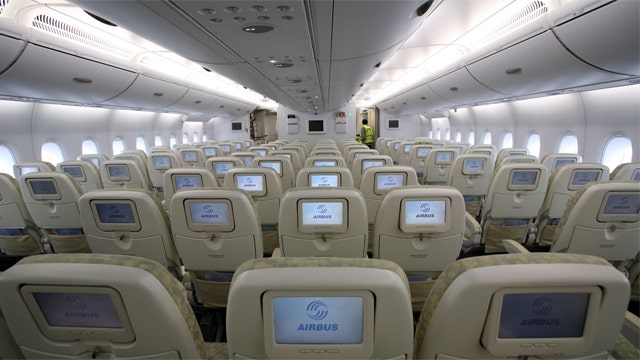Lawmakers in the House and Senate have come together once again to convince airlines to establish some decent space for fliers.
Dubbed the Seat Egress in Air Travel (SEAT) Act, the bill was introduced in Congress Thursday and is modeled after previous amendments to the Federal Aviation Administration Authorization Bill introduced in 2016.
Rather than bow to the airline industry’s inventive ways cram more and more passenger seats into the cabin, the new bill would essentially force airlines to manufacture seats with a minimum size and create a minimum set distance between them to allow for sufficient legroom.
THIS NEW AIRPLANE DESIGN COULD END MIDDLE SEAT MISERY
The FAA would be able to establish the final industry standard seat size, but Rep. Steve Cohen, D-Tenn., said in a statement that “airline passengers are tired of being squeezed.”
“Shrinking seat sizes in airplanes isn’t just a matter of comfort but the safety and health of passengers as well. Planes need to be capable of rapid evacuation in case of emergency. In addition, doctors have warned that deep vein thrombosis can afflict passengers who do not move their legs enough during longer flights,” said the congressman.
Calls to regulate airplane seat sizes have been mounting for years.
“Airlines are aggressively reducing seat and passenger space to squeeze more revenue out passengers, despite health and safety being threatened,” Paul Hudson, president of FlyersRights.org, an advocacy group for air travelers told Elliott.
The average “pitch” — the industry term for the amount of space between airline seats has decreased four inches, going from 35 inches before airline deregulation in the 1970s to about 31 inches today. The average width of an airline seat has also shrunk about two inches-- from 18 to about 16.5 inches today.
Last year, Airbus submitted a patent for a “Re-configurable Passenger Bench Seat” with adjustable chairs and seatbelts which will allow airlines to accommodate people of different shapes and sizes. According to the U.S. Centers for Disease Control and Prevention's National Center for Health Statistics, since the 1980s Americans have gained, on average, 15 pounds.
In October, two American Samoan businessmen filed complaints with the U.S. Department of Transportation alleging they may have been the target of discrimination after being weighed while boarding a flight from Honolulu.
In the complaints, the men also said they were assigned new seats (to properly redistribute the weight on the plane) they did not originally select.
FOLLOW US ON FACEBOOK FOR MORE FOX LIFESTYLE NEWS
“The number one complaint I hear from travelers is shrinking legroom and cramped seats,” Senator Charles Schumer said in a statement.
According to a new study published last year in the Proceedings of the National Academy of Sciences, passengers seated in economy class were 3.8 times more likely to have an incident of air rage if they were on a plane that had a first-class section.
And those same travelers were 2.18 times more likely to have an outburst if they had to walk through first class to board the plane, as opposed to boarding in the middle of the plane in their assigned section.
If this bill passes, budget carriers like Spirit and Frontier might be forced to reconfigure current plane cabins— likely resulting in higher fares to make up for the lost seats.

